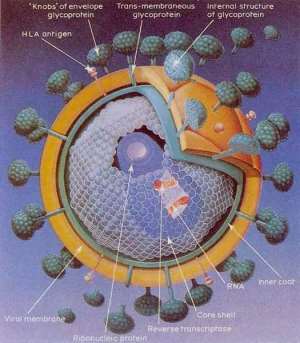
Scientists in the United States have taken a close up, three-dimensional look at spike proteins on the surface of the AIDS virus which could speed up the search for a vaccine.
The proteins, known as gp120 and gp41, allow HIV which causes AIDS to bind and fuse with human cells.
"We've got the first really good look of what the whole virus looks like to the point that we can see the spikes on the surface of the virus," Professor Kenneth Roux, of Florida State University in Tallahassee, said in an interview on Wednesday.
The proteins are the only two molecules on the surface of the virus and are obvious targets for an effective vaccine which is considered the Holy Grail in the battle against HIV/AIDS -- an illness that has killed 25 million people since the first cases were reported in 1981.
Dozens of AIDS vaccines using different approaches are being developed and tested. Roux believes part of the reason vaccines have failed so far is that, although scientists were aware of the spike proteins, nobody had really known how the spikes were put together.
"Without that knowledge it makes it (vaccine development) more of a shot in the dark," he said.
TRIPOD STALK
Roux and his team used a technique called cryoelectron microscopy tomography to get a close look at the intact spikes on HIV, which has about 14, and a similar monkey virus which has 73.
Their findings, reported online by the journal Nature, show that the spikes consist of three gp120 proteins that make up the protruding cap and three gp41 proteins that make up the stalk.
"One of the biggest surprises was that the stalk, which is one of the major components of this, which is called gp41, instead of being a tight collection of three rods is more like a tripod where the three legs would be spread on the surface of the virus," said Roux.
"There are already two labs, that I am aware of, which have taken this information and are using it to try to redefine the vaccine," he said.
Scientist have not been able to scrutinize the intact spikes on the virus in such detail until now because the technology was perfected only in recent years.
Roux and his team are hoping to get more information about how the stalks of the spikes are put together. They may also use the technology to look at other viruses.
More than 40 million people worldwide are living with HIV/AIDS, including about 25 million people in sub-Saharan Africa.




 Avoid pre-registered SIMs, buyer and seller liable for prosecution – Ursula Owus...
Avoid pre-registered SIMs, buyer and seller liable for prosecution – Ursula Owus...
 Election 2024: Mahama has nothing new to offer Ghanaians, Bawumia is the future ...
Election 2024: Mahama has nothing new to offer Ghanaians, Bawumia is the future ...
 OSP files fresh charges against ex- PPA Boss
OSP files fresh charges against ex- PPA Boss
 Withdraw unreasonable GH¢5.8m fine against former board members – ECG tells PURC
Withdraw unreasonable GH¢5.8m fine against former board members – ECG tells PURC
 Akroma mine attack: Over 20 armed robbers injure workers, steal gold at Esaase
Akroma mine attack: Over 20 armed robbers injure workers, steal gold at Esaase
 Those who understand me have embraced hope for the future — Cheddar
Those who understand me have embraced hope for the future — Cheddar
 Ghana will make maiden voyage into space should Bawumia become President — Chair...
Ghana will make maiden voyage into space should Bawumia become President — Chair...
 Train crash: Despite the sabotage, we shall not be deterred and will persevere —...
Train crash: Despite the sabotage, we shall not be deterred and will persevere —...
 Tema-Mpakadan railway project a perversion of the original viable concept design...
Tema-Mpakadan railway project a perversion of the original viable concept design...
 Train crash: Elsewhere, everyone involved in the test will either be fired or re...
Train crash: Elsewhere, everyone involved in the test will either be fired or re...
